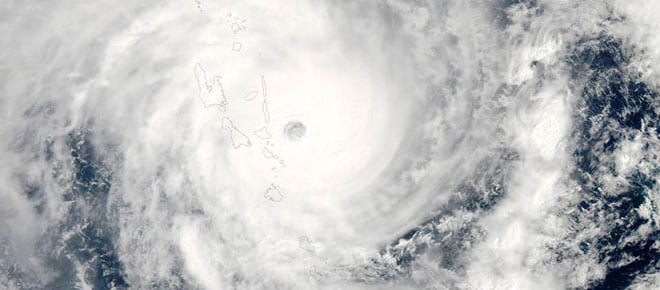After a last minute change of course to the west Cyclone Pam made a direct hit on Vanuatu last night, tearing through the archipelago with winds of up to 250kmh. With more than 250,000 people at risk from the severe tropical cyclone there is real concern of a potentially high death toll and of enormous destruction, particularly given the traditional housing that is so prevalent through the islands.

After a last minute change of course to the west Cyclone Pam made a direct hit on Vanuatu last night, tearing through the archipelago with winds of up to 250kmh.
With more than 250,000 people at risk from the severe tropical cyclone there is real concern of a potentially high death toll and of enormous destruction, particularly given the traditional housing that is so prevalent through the islands.
Oxfam is now preparing to respond to what is likely one of the worst cyclones ever seen in the Pacific region and will be sending a rapid response assessment team to Vanuatu as quickly as possible to assist Oxfam staff already on the ground.
The highly populated island of Efate, which includes the Vanuatu capital Port Vila, was directly in the path of the cyclone. Early reports indicate roads are blocked, and emergency crews are now working to get through to communities.
The cyclone, which appeared to intensify as it hit Vanuatu, is still moving through the southern islands of Vanuatu which have much less infrastructure and could be seriously damaged by a cyclone of this magnitude.
Beginning to see extent of damage in Vanuatu from mega-storm Cyclone Pam. @350Pacific #PrayForThePacific #TCPam pic.twitter.com/FRWlv8bAlU
— 350 dot org (@350) March 13, 2015
Oxfam New Zealand’s Executive Director Rachael Le Mesurier said depending on how many people evacuated, the cyclone could be devastating for Vanuatu.
“Oxfam and other humanitarian agencies are ready to respond with emergency stocks available to be moved into stricken areas if required,” Ms Le Mesurier said.
Vanuatu Country Director Colin Collett van Rooyen was in regular contact last night, and said the sound of the winds was terrifying, and came with astounding force leaving his house and other buildings shaking for hours.
“It’s clear now that we are heading for possible worst case scenario,” he said late last night. “This is big.”
He said plans were already underway for the response and said it would take time for Vanuatu to rebuild.
“This will devastate not just homes but livelihoods as well,” he said.
“Port Vila was recently named in the Natural Hazards Risk Atlas and is known as the city most exposed to natural disasters in the world because it faces a combination of risks including earthquakes, tsunamis, flooding and tropical cyclones such as Cyclone Pam.”
Cyclone Pam is now directly over Tanna Island with a population of 28,000 people and some of Vanuatu’s most vulnerable communities.
You can support Oxfam’s response to humanitarian crises by donating to our Disaster Response Fund https://www.oxfam.org.nz/donate/5024





